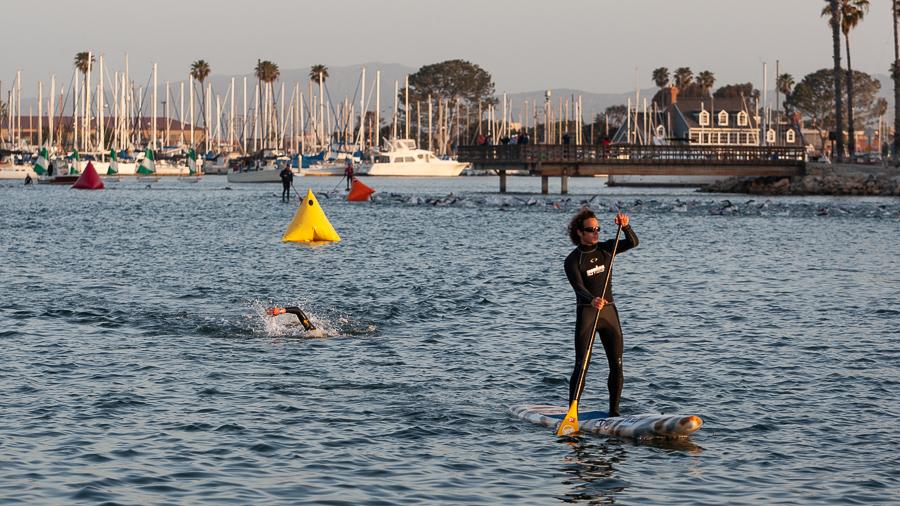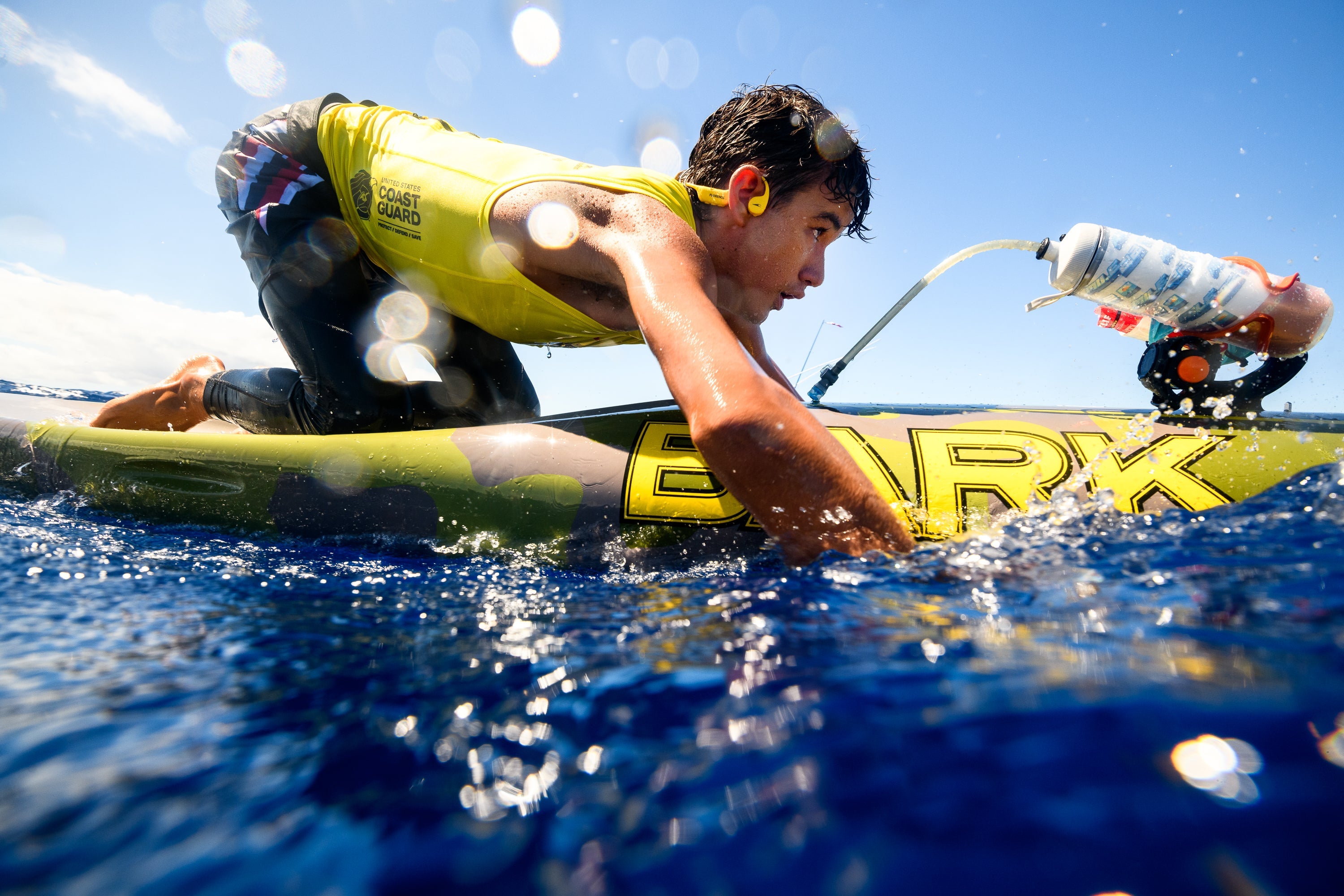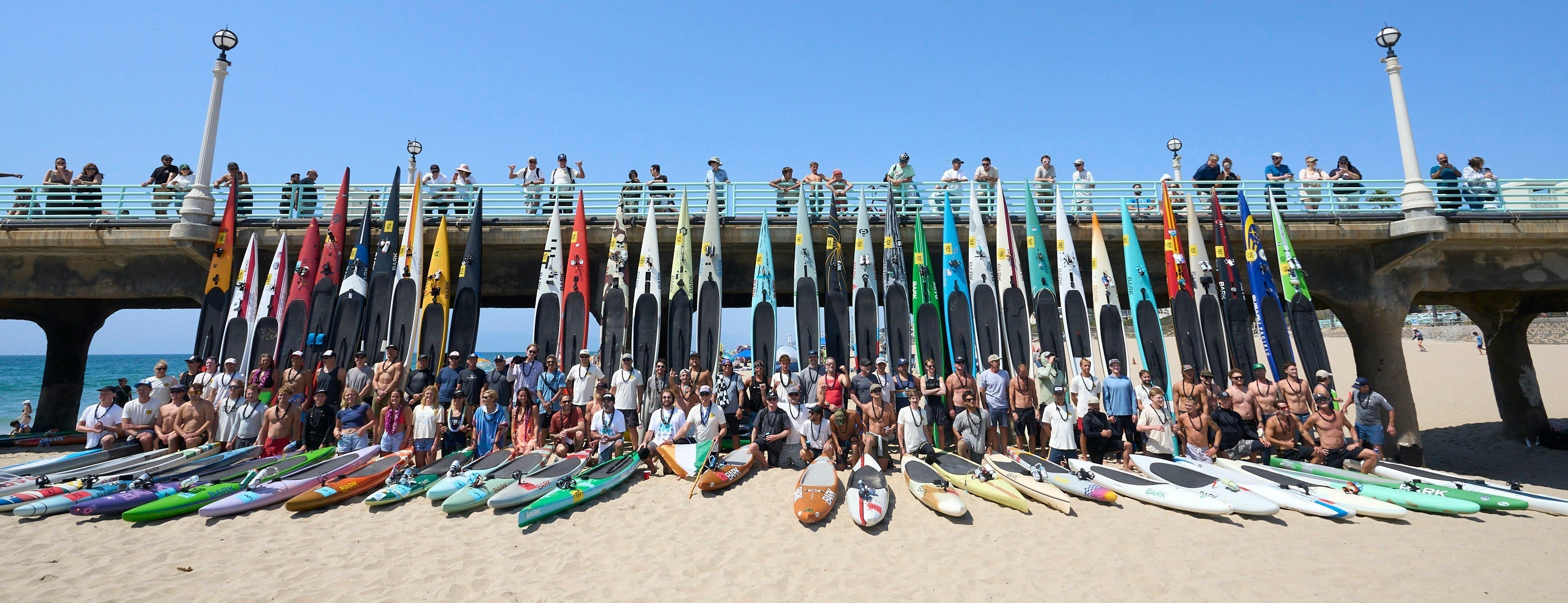New triathlon course includes beach start and open-water swim.
Participants in April’s Ironman 70.3 Oceanside triathlon could be the first to swim a new course that includes half a mile of open water.
In an effort to put the “ocean” back in Oceanside, Ironman changed the swim course before last year's event. But, because of safety concerns related to high surf, the updated course wasn’t used.

The Ironman 70.3 Oceanside triathlon debuted in 2002 and it has used the same swim course during each of its 17 editions; the now-familiar (to thousands of triathletes) out-and-back swim starts and finishes at a boat ramp inside Oceanside Harbor.
The swim at "Oceanside"—an event many consider the triathlon season opener—has always been an ocean swim, in a sense, but it couldn’t be called “open water” because its entire 1.2-miles were within the protected break walls of the Harbor.
All of this changed (on paper, at least) for 2018, when Ironman organizers moved the location of the swim start. Instead of at the boat ramp, as per tradition, the swim start is now located on Harbor Beach, outside of the Harbor itself and in between two jetties (known as the “North Jetty” and the “South Jetty”). This variation means that swimmers will start on the beach, swim north along the coast for four-tenths of a mile, enter the harbor mouth, and then exit at the boat ramp (and the first transition area). See a map of the Ironman 70.3 Oceanside swim course here.
According to Ironman, the change was made for a couple of reasons: “We know that there are some great swimmers who don’t often get “hilly” [challenging] swims, and we believe that surf-swimming is part of the essence and history of our sport.”
The planning, permitting and, for some, the nerves that led up to the 2018 race were ultimately for naught. Two days prior to the event, the open-water course was deemed unsafe by City of Oceanside Lifeguards, and race organizers chose to go back to the traditional Harbor course.
While it didn’t run in 2018 and it’s never been used by Ironman, the updated course is now the official swim course of Ironman 70.3 Oceanside; if you’re signed up for the April 2019 event, you can expect to be among the first to experience the beach start and true open-water ocean swimming.
The swim in Oceanside will almost certainly deliver the desired effect (challenge/authenticity): Swimming in open water can be far more challenging than swimming in the shadows of a jetty, protected from the elements. Current, swells, and especially breaking waves, can wreak psychological havoc on triathletes who train exclusively in a pool. On the flipside, your sinuses will thank you (a little less Harbor water never hurt anyone), and, if the waves are thumping but just under the four-foot limit, you’ll have a little extra something to write home about/post on Instagram. Not to mention, a new swim course means a new course record for someone! (Records set on the “easier” Harbor swim course will likely carry an asterisk going forward.)
Tactics, Tactics, Tactics
What should you expect if the beach start is used in 2019? From the logistics involved in starting and exiting the swim in different locations, to negotiating the surf, and then encountering ocean elements, like swell, wind chop, and maybe even kelp, the Oceanside swim will be an entirely different experience.
Preparing for the beach start and open-water portion of the swim course is twofold. Physically, it’s more about tactics than technique (good swimming is good swimming). Mentally, it’s—well, mental.
The surf itself can stop even professional-level pool swimmers at the beach.
“The key is to dive through waves, rather than stand up and get pulverized,” says swim coach and San Diegan, Jim Vance. He adds: “Never go backward.”
Once through the waves, a quick assessment of the conditions and cues (like a mouthful of water) will help participants determine how to adapt. For example, swimmers should be prepared to breathe from either their left or right side, depending on the wind direction.
In a likely scenario, the wind may be blowing offshore (from the beach toward the ocean) during the morning. In this case, as swimmers head north toward the Harbor entrance, small waves—or “wind chop”—and spray could buffet their right sides, making it difficult to get a breath without also taking in a gulp of salt water.
Significant surface chop and even rolling swells can also make sighting a challenge. Consider more frequent and longer looks—especially for red turn buoys—than you would regularly need in calm water.
When it comes to nailing the mental game, there’s no substitute for the real thing. If at all possible, get yourself to the beach a couple of times (even if it’s during race week) before putting it all on the line. The beach/ocean is open to swimming. The Harbor, however, is not.
There is one opportunity to practice (albeit, for the 2020 triathlon) the exact Ironman swim course, including the Harbor and boat-ramp exit. It’s via a popular local swimming event called the Tiki Swim. Now in its ninth year, the Tiki Swim has traditionally been the only legal way to swim from the ocean into the Harbor. The September swim consistently sells out with 500 participants, but event organizer Brian Long says he expects to increase the size of future events to accommodate interested triathletes. (For TikiSwim information, see its website.)
Read: Swimming for Triathletes
“Go” or “No-Go”
Whether or not the new swim course is used this year ultimately depends on the surf—and City of Oceanside Lifeguards. Lifeguards tell us that, if the wave height is forecasted to be more than four feet [on the face of a wave], they’ll move the swim to the Harbor, as was the case in 2018.
Lifeguards and Ironman race organizers use the surf forecasting website, Surfline.com, to help them in the decision-making process. And, they make the call—new course or “old” course—at least 48 hours ahead of the event’s start.
Participants can also stay abreast of conditions by checking Surfline.com during the days leading up to the event. The website reports on current conditions and forecasts wave height, swell direction, wind speed (and direction), and tides. (Paying members get a 17-day forecast.) Surfline is also home to a free live webcam that shows real-time beach/surf conditions at Oceanside Harbor. (This view is from about 150 yards north of the swim start and it shows the entrance to the Harbor).
Planning and preparedness aside, one can only speculate (pray/offer sacrifices) about which course will be used come April 6. Strong athletes with a background in ocean swimming are likely looking forward to open-water (minus the spooky kelp that’s sometimes found on this part of the coast); it can play to their advantage. However, if recent conditions are any indication, participants who would prefer an Ironman 70.3 on the mild side—and the traditional swim course—might be in luck. All of Southern California has been experiencing consistent swell activity so far this winter. What local-area surfers consider “better than average” surf, could mean that Ironman triathletes won’t swim the new course until 2020—maybe.—Kurt Hoy
Kurt Hoy is a freelance writer and the former content director for Triathlete magazine, Inside Triathlon, VeloNews, and Competitor Running. He writes about endurance sports, technology, and everything “best life.”




Share:
Swimming for Triathletes: Part One
H2O Insider: How to Get the Right Headphone Fit